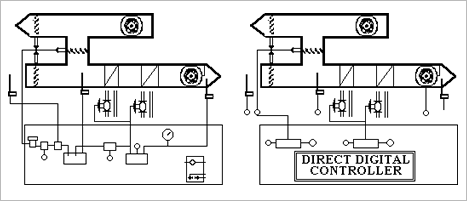 This course is designed to introduce HVAC personnel to the concepts of computer Direct Digital Control systems. Individuals who attend this seminar should have a good background in HVAC systems and conventional (pneumatic and/or electronic) control principles. Attendees to this seminar can expect to gain a good theoretical and practical working knowledge of the operations of DDC control systems.
This course is designed to introduce HVAC personnel to the concepts of computer Direct Digital Control systems. Individuals who attend this seminar should have a good background in HVAC systems and conventional (pneumatic and/or electronic) control principles. Attendees to this seminar can expect to gain a good theoretical and practical working knowledge of the operations of DDC control systems.
Monday
Summary of control systems types (electronic, pneumatic, computer) and their advantages and disadvantages. Control fundamentals such as two-position, modulating, proportional integral derivative. Sequencing of pneumatic actuators. Electric and electronic fundamentals. Ohm's Law, voltage, current and resistance principles and formulas. AC and DC circuits. Series, parallel and series/parallel circuitry. Relay logic. Microprocessor and computer operation and concepts. How a computer processes input information from sensors to output devices to perform HVAC control program. Operation of a PC and its component parts. Basic Windows commands and structure. Prior personal computer experience is not necessary. We will address basic personal computer (PC) operations during the seminar.
Tuesday
Input and output devices. Temperature, humidity and pressure sensors. Transducers used for pneumatic interface. Thermistors, Balco, platinum, solid state temperature sensors. Temperature, humidity and pressure transmitters. relays, E.P.s and Transducers using 4-20ma, 0-10VDC and PMW input values. PC's will be available at each simulator station for use. Class will be divided into no more than 3 personnel per simulator station for practical training on DDC hardware. Each station has a DDC control panel, 486 personal computer and various input and output devices for control simulations. Pneumatic valves and damper operators are included with transducer interface from the DDC.
Wednesday
The control software. How to design, implement and debug the operations program of a DDC control system. Comparison of an electric ladder diagram on a programmable controller to an operations program. How to translate from a good operational sequence of operations into an effective DDC program. A mouse selected, menu driven programming language will be used to allow easy intuitive programming of the DDC panels. Various control strategies will be set up to include converters, air handling units and chiller operations sequences. All simulators are shown in real time on graphics of the systems being simulated. The simulators allow the students to manually change temperature (simulated) input value to the DDC controllers and observe the resulting output values (analog or two-position) to the terminal control devices.
Thursday
Continuation of Wednesday format on designing, programming and debugging an operations program for DDC. How to test and troubleshoot the DDC control system hardware and software. Testing of temperature, humidity, and pressure sensors. Troubleshooting output devices such as pilot relays, E.P.s and transducers.
Friday
Reading and understanding the DDC control drawings. Various control prints will be examined for the information conveyed on the control system drawing. Systems drawings brought in by the attendees can be used if applicable. How to insure that quality understandable drawings are available for operations personnel to use for troubleshooting and operation. How to work with a controls installation contractor to insure a good DDC installation. How to keep the system to the KISS principle of design (Keep It Simple Stupid). Learning to control the technology rather than the technology controlling you.
NOTE: Each attendee will receive a DDC textbook, various manufacturers' data sheets and a completion certificate.